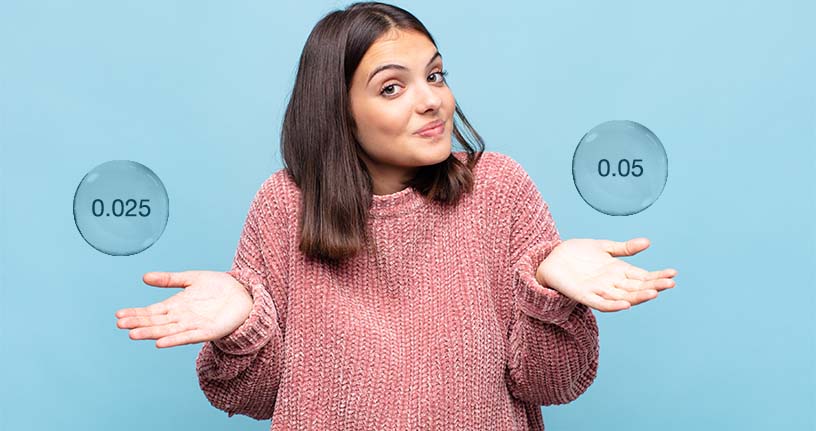Which Tretinoin Gel 0.025 / Tretinoin Gel 0.05/ 0.1 strength should you choose? Well, this is a common question for those who have just been introduced to this wonderful skincare agent. The advantage of using Tretinoin is that it is available in different strengths. In this article, we will discover the best strength to start with and if there is the best Tretinoin strength for acne, wrinkles, and hyperpigmentation. We will also explore Tretinoin gel strengths comparison and determine what’s best.
What is Tretinoin?
Tretinoin is categorized under the class of medications known as retinoids or Vitamin A analogues. While there are retinoids like retinol that are widely available over the counter. However, they are not as effective as prescription retinoids like Tretinoin. It is believed that Tretinoin is about 20 times more potent than retinol.
Tretinoin smoothens and exfoliates the skin while reducing oil production and acne and fighting sun damage. It offers improvement in skin tone, texture, and appearance. It has a long track record of safety. It is supported by extensive research studies for its effectiveness in treating acne vulgaris, enhancing skin texture, even out skin tone, and fading fine lines and wrinkles. The product has come either as a single ingredient or with other products like hydroquinone and antibiotics. The topical application of Tretinoin promotes rapid cell turnover and enhances collagen production by your skin cells. It is a medicinal product; hence, it is available only by prescription. It is also important to follow a proper Tretinoin dosage guide prescribed by your dermatologist.
Tretinoin strength studies
Tretinoin comes with various strengths. The most commonly encountered strengths in generic and branded preparations like Retin A and Retino A are 0.025%, 0.05% and 0.1%.
Tretinoin 0.025 vs 0.05: These different strengths of the medicine are available with a range of potency from mild to strong. It is believed that 0.025% is up to five times stronger than the highest concentration of over-the-counter retinol. It is generally considered best for those who have tried their hands for the first time or those with sensitive skin or rosacea. It effectively treats acne and early signs of ageing. Moving up, the 0.05% Tretinoin for acne and wrinkles is thought to be ten times stronger than any other over-the-counter retinoids available in the market. It is popularly known for its enhanced effectiveness in fading fine lines and improving skin texture without being harsh.
For those suffering from severe acne, hyperpigmentation, or wrinkles, a higher strength of 0.1% Tretinoin may be required. This highest strength is believed to be up to twenty times stronger than retinol. However, with increased strength, the likelihood of side effects increases. These include redness, dryness, peeling, purging and post-inflammatory hyperpigmentation. Therefore, it is important to approach a higher concentration with caution. This is also the reason why it should only be used under the supervision of a dermatologist. Your dermatologist will collect information from you about the severity of the skin condition and your existing skincare routine. Such information will be used to determine which tretinoin strength is ideal for you to initiate treatment with. Once you tolerate the initial dose, your dermatologist may adjust the frequency and dose of your Tretinoin formulation based on how your skin responds to the treatment. This helps ensure optimal results with minimal Tretinoin side effects.
The best tretinoin strength for different skin concerns
Numerous factors interfere with your dermatologist’s decision regarding which Tretinoin strength to begin with. Usually, the lowest dose is recommended for those with sensitive skin or those who are beginners in the Tretinoin world. However, individuals with a history of retinoid use and tolerance to this active skincare agent may be prescribed with a higher strength. Generally, for most people, treatment begins with the lowest dose and gradually goes up in strength over time. However, not everyone will need to reach the highest dose of 0.1% Tretinoin either because they do not need it as they may have significant improvement with the lowest dose or because their skin can’t tolerate it. Therefore, the optimal strength to begin or continue for some time majorly depends on your skin problems and tolerance.
For those dealing with mild to moderate acne, a starting dose of 0.025% is generally suggested. This offers an effective treatment option while minimizing irritation and other mild side effects associated with it. As the skin adapts, the dose may increase; some may benefit from increasing strength to 0.05% and then to 0.1% if needed to increase the effectiveness of acne-fighting properties. When treating wrinkles such as fine lines and uneven skin tone, a 0.05% tretinoin strength might sometimes be a good starting point for those with a history of prolonged usage of retinol and who do not suffer from any allergic reaction, sensitivity or skin inflammatory conditions. For more intense anti-ageing effects, including deeper wrinkles and significant sun damage, a 0.1 strength can be prescribed as needed.
Does a higher strength work better
The idea of using a higher strength for better results is a common misconception. The truth is that the optimal strength of the Tretinoin varies depending on an individual’s skin concern and tolerance. Although the higher strengths are more effective and may offer rapid or more pronounced results, they also carry an increased risk of adverse effects. This is the reason why dermatologists always recommend a low initial dose, especially for someone with sensitive skin or new to Tretinoin.
Verdict!
The goal is to find the lowest concentration that effectively addresses all your skin concerns while causing the least amount of irritation. In addition, consistency is a key to treatment when it comes to achieving results with Tretinoin. This is regardless of the strengths. Over time, even low strengths can cause a significant improvement in acne, fine lines, skin texture, and other signs of ageing. For best results, follow a Tretinoin dosage guide provided by your dermatologist.


